After 19 years of waiting, Al-Sadaqah Hospital in Yemen has a new x-ray machine thanks to WHO and World Bank
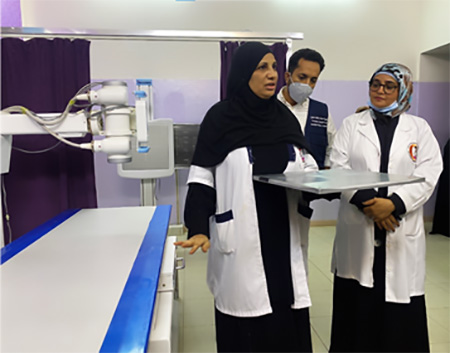 General Director of Al-Sadaqah Hospital Dr Kefaya Al-Gazaie, Manager of the Radiology Department Dhikra Abdulraheem and WHO Technical Officer Dr Amgad Abdulqawi discuss the impact that the new digital x-ray machine will have on the population of Aden and surrounding governoratesAden, 5 December 2021 – With the crisis in Yemen profoundly impacting the country's health system, WHO is strengthening service delivery at hospitals across the country through the World Bank-supported Emergency Health and Nutrition Project (EHNP). One such facility is Al-Sadaqah Hospital in Aden where, after 19 years of relying on an increasingly outdated and underperforming x-ray machine, the hospital staff finally received a new one.
General Director of Al-Sadaqah Hospital Dr Kefaya Al-Gazaie, Manager of the Radiology Department Dhikra Abdulraheem and WHO Technical Officer Dr Amgad Abdulqawi discuss the impact that the new digital x-ray machine will have on the population of Aden and surrounding governoratesAden, 5 December 2021 – With the crisis in Yemen profoundly impacting the country's health system, WHO is strengthening service delivery at hospitals across the country through the World Bank-supported Emergency Health and Nutrition Project (EHNP). One such facility is Al-Sadaqah Hospital in Aden where, after 19 years of relying on an increasingly outdated and underperforming x-ray machine, the hospital staff finally received a new one.
Hospitals in Yemen are struggling to meet the increasing demands for essential care, coupled with deteriorating infrastructure, equipment and services. "Since 2002, we had been working with another x-ray machine that insufficiently diagnosed cases, forcing many patients to go to an expensive private clinic,” said Dhikra Abdulraheem, Manager of the Hospital’s Radiology Department.
The state-of-the art, digital x-ray machine is already enabling the hospital’s pediatric department to better treat a growing influx of patients. “Now, instead of paying five times more at a private clinic, they can receive the same accurate diagnosis at a much more affordable cost,” added Abdulraheem.
Improved image diagnostic capacity will enable doctors to effectively detect severe acute lower respiratory tract infections, which will reduce the risk of infection-related mortality in children under five.
Abdulraheem elaborated that the machine will also diagnose adult cases, which is key to meeting the needs of an ever-growing number of patients -- including internally displaced people -- hailing from many different governorates. “We have suffered a long time, especially during the last four years of this seven-year conflict,” added Abdulraheem, “Now, thanks to the arrival of this new x-ray machine, we can finally treat more patients.”
COVID-19 treatment centres: the first line of defense in saving Yemeni lives
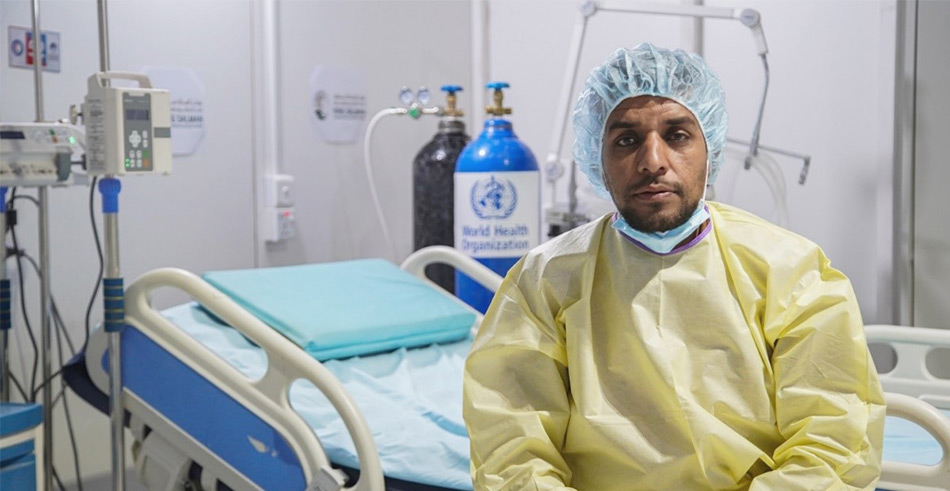
15 December 2021 - Thirty-eight-year-old Wajdi Sweidan, a lab technician at Tarim Hospital, in Hadramout, contracted COVID-19 while he was taking samples from a patient. After recovering, his family tried to convince him to stop working at the centre, but he was determined to help patients get through the “harshest illness” he has ever experienced.
Amid the conflict in Yemen, mass campaigns to end the threat of tropical diseases continue
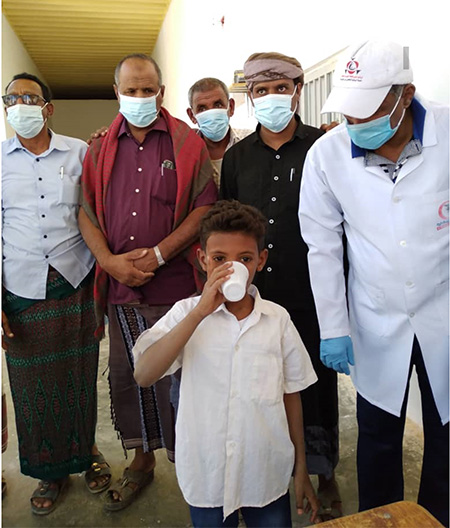 14 December 2021 –- Schistosomiasis and soil-transmitted helminths are neglected tropical diseases (NTDs), but these parasitic worm infections can lead to anaemia, malnutrition, and learning difficulties among children. Left untreated, schistosomiasis can damage the liver, intestines, bladder, spleen and lungs, while soil-transmitted helminths can cause a range of problems, including slow physical and mental development.
14 December 2021 –- Schistosomiasis and soil-transmitted helminths are neglected tropical diseases (NTDs), but these parasitic worm infections can lead to anaemia, malnutrition, and learning difficulties among children. Left untreated, schistosomiasis can damage the liver, intestines, bladder, spleen and lungs, while soil-transmitted helminths can cause a range of problems, including slow physical and mental development.
Public health authorities have battled for more than a decade to tackle schistosomiasis, supported by partners such as the World Bank’s International Development Association (IDA) and World Health Organization (WHO). In 2010, one in five residents in Yemen is at risk of contracting schistosomiasis, better known as bilharzia. Today, this figure has dropped to fewer than one in 15 (about three million people). Although limited data exist on the soil-transmitted helminths that affect communities across the country, bringing these infections under control is another public health goal.
Eliminating schistosomiasis involves the mass administration of drugs, with members of a target population being treated once a year. Several rounds of drugs are administered over several years to get rid of a community of the parasite. The Emergency Health and Nutrition Project (EHNP) funded by IDA, the World Bank’s fund for poorest countries, has helped to eliminate schistosomiasis as a public health problem in Yemen.
“Nothing beats a child’s smile. This project represents a critical opportunity to decrease the disease burden among vulnerable Yemenis, particularly children. The project is part of the World Bank’s strategy to invest in Yemen’s most important assets: its people,” said Tania Meyer, World Bank Country Manager for Yemen.
During a recent four-day mass campaign, almost 860 000 children and adolescents between six and 19 years of age, were targeted (whether enrolled in school or not) across seven southern and eastern governorates: Abyan, Hadramout/Mukalla, Hadramout/Sayoun, Lahj, Mareb, Shabwa, and Taiz. In total, 37 districts, 373 team leaders, 1070 team supervisors, and 2140 drug distributors were involved and over 80% of the target population reached.
Yemen is making progress against other neglected tropical diseases as well. Lymphatic filariasis, which causes swelling of limbs and is spread by infected mosquitos, was eliminated as a public health problem in 2019. The administrative certification of the elimination of leprosy in Yemen is underway, and technical teams are working hard to eliminate blindness of infectious origins: trachoma by 2024, and onchocerciasis, or river blindness, by 2030.
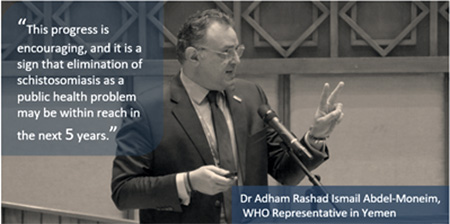 “This progress is encouraging, and a sign that the elimination of schistosomiasis as a public health problem may be within reach in Yemen in the next five years,” said Dr Adham Rashad Ismail Abdel-Moneim, WHO’s Yemen Representative. “Reaching it, however, will depend on continued support from partners.”
“This progress is encouraging, and a sign that the elimination of schistosomiasis as a public health problem may be within reach in Yemen in the next five years,” said Dr Adham Rashad Ismail Abdel-Moneim, WHO’s Yemen Representative. “Reaching it, however, will depend on continued support from partners.”
The campaign was carried out in close collaboration with Yemen’s Ministry of Education and the Health Education Centre, which is part of the Ministry of Public Health and Population. Technical and statistical local plans were prepared, a training of trainers’ session carried out, and workshops given to drug distributors and the heads of teams in charge of both fixed and mobile treatment facilities. A third-party team conducted direct monitoring of the activities and interviews with around 4000 people across 1000 randomly selected households.
The campaign in January 2021 targeted 2.4 million people at 3300 sites across 32 districts in seven northern governorates, involving 6700 drug distributors. Approximately, 4.8 million praziquantel tablets and 2.4 million albendazole tablets were distributed.
More mass campaigns against soil-transmitted helminths and schistosomiasis are planned for 2022, with more investment made to improve community engagement in order to reach more than 80% of the targeted population in the future.
Related link
The Enemy Within: Tackling Schistosomiasis in Yemen, World Bank, 7 April 2014
Essential Health Services Project, supported by the King Salman Humanitarian Aid and Relief Centre, is a lifeline for millions across Yemen
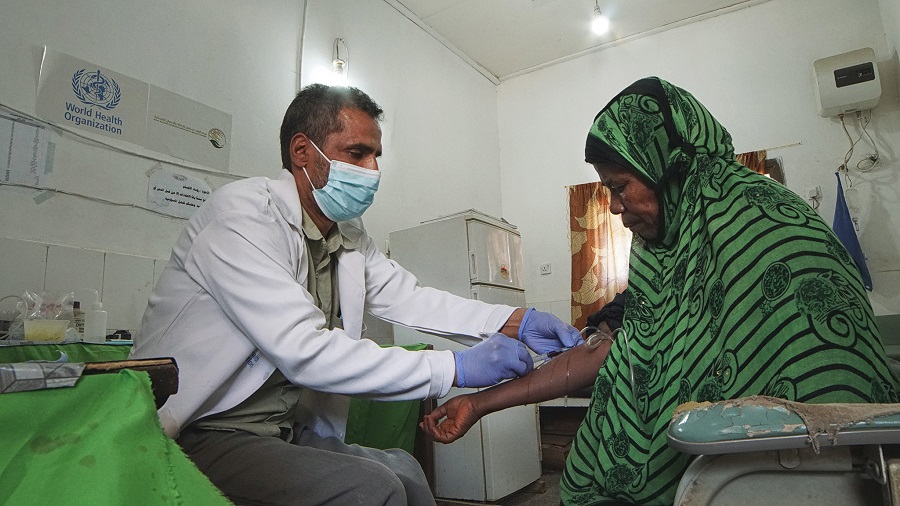
5 December 2021 – The conflict in Yemen has taken a dreadful toll on the health infrastructure. Almost 7 years of active conflict has impaired the availability and quality of health services to the most vulnerable. Leaving over 20 million civilians in need of health assistance. If that is not enough, the emergence of COVID-19 has exacerbated existing pressure on health facilities and civilians who barely have access to basic health services.
WHO has led the health efforts during such difficult times along with the Health Cluster and local health authorities to mitigate the risks and strengthen the health system in one of the most complex operational environments.
In partnership with the King Salman Humanitarian Aid and Relief Centre (KSrelief), and as part of large-scale efforts to support health in Yemen, WHO leads the Essential Health Services Project – a US$ 20 500 000 project that aims to enhance Health Cluster coordination and improve access to the Minimum Service Package in vulnerable and priority districts across the country.
WHO and KSrelief, through this project, support Lawdar hospital in the Abian governorate. Dr Nabil Hussein is the Director of Lawdar hospital. He has been working at the hospital for 25 years now. “We receive 200 to 250 cases per day. Which exceeds our operational capacity,” he says.
Hundreds of people come to Lawdar hospital from surrounding districts to seek medical care, specifically surgical care as it is the only hospital that offers surgical care in the area.
“The pressure is extreme and the resources are scarce. But we ensure our best effort as much as operational capacity allows. The hospital is in dire need of more health staff and specialized health care professionals due to the pressure and the number of patients coming in. More needs to be done, and we are looking forward to continued support by WHO and KSrelief,” Dr Nabil adds.
“We are grateful for the continued dedication of WHO in such difficult circumstances. The support we received has been substantial. The hospital has been equipped with machines, medical and non-medical supplies. The efforts also included support to our therapeutic feeding centre and the COVID-19 isolation units. Not to mention the highly beneficial quality care training that was offered to health staff in the hospital,” he says.
Through the Minimum Service Package, WHO was able to provide medical supplies, medicines, laboratory supplies, oxygen supply and medical equipment to targeted health facilities. This has ensured improved access to quality health services and technologies are available for over 6 million people in need. In addition, the project ensured provision of fuel and a safe water supply to maintain functionality of health facilities and crucial delivery of health care services.
The project helps support increased access to medical care and essential health services and improved quality of health care services in 19 health facilities. Aiming to reach approximately 2.3 million people through the project activities. In addition to supporting 206 health facilities with fuel, which in turn supported access to health care for over 733 000 people. Through the Minimum Service Package, 1.2 million consultations were conducted of which 74 000 were consultations for internally displaced persons (IDPs). Through the project, computed tomography scan (CT scan) and magnetic resonance angiogram (MRA) were provided to targeted health facilities, assisting around 73 000 patients seeking medical care at these facilities each month.
The project supports the operational needs of 26 emergency operation centres across Yemen that play a pivotal role in providing real-time information, assessing the needs and the COVID-19 response, receiving alerts, as well as coordinating and managing response interventions. This helps promote integrated preparedness and response operations with 36 partners across UN and non-UN organizations.


